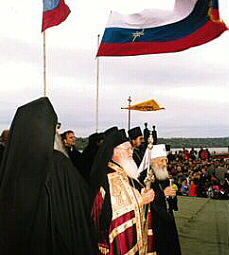 |
| It takes specially trained teams to remove
unexploded ammunition |
The challenging and risky activities of searching the Danube River bed
and removing unexploded mines, leftover from NATO intervention in 1999,
began on February 27th, 2002 near Novi Sad. The city, one of the most beautiful
towns in northern Serbia, is situated on the banks of the second largest
river in Europe.
Following an international tender for the cleaning of the Danube, the Danube
Commission from Budapest signed agreements with the foreign and domestic
firms hired for the job. Five projects were agreed upon: removal of the
unexploded ammunition, removal of the remnants of three destroyed bridges
– the Sloboda, Zezeljev and Petrovaradinski – and the future regulation
of the Danube bed.
Removal of the unexploded ammunition is to be carried out by the Belgrade
firm PMC INZENJERING, which is part of the Serbian company JUGOIMPORT-SDPR.
The works are valued at 1,8 million euros. Specially trained teams on boats,
divers and pyrotechnist began combing about 300 hectars of the river. The
area starts from about 150 meters up the stream from the Sloboda bridge,
ending about 150 meters down stream from the Zezeljev bridge. The Danish-Hungarian
consortium COWI-Utiber estimated that there are at least eight unexploded
mines in the area. They should be located, deactivated, removed from the
Danube and transported to testing ground in Nikinci and Centa (both in Serbia)
for destruction. So, the mines will not be destroyed while on the river
bed, unless presenting an excessive risk. The teams will get technological
assistance in their dangerous work from the robot ROMAN, made by the Swedish
firm INVO AB. ROMAN is guided by remote control, weighs eight tons, and
has spider-like legs, that reach up to 14 meters. The robot is capable of
doing the most dangerous and complicated tasks.
Specialists at work
 |
| A prayer for peace. |
The team of 25 experienced divers and demolitionists is led by Colonel
Slobodan Jovanovic, who has long been doing this work in which you can make
a mistake only once, for a long time. As Jovanovic told, in the last three
years - during and after the NATO intervention in Yugoslavia - his team
has deactivated 3,500 mines.
The most dangerous phase of the project – the cleaning of the Danube
at Novi Sad – is scheduled to last 70 days. It will be supervised by
the Swedish Army’s Deactivating Center (SWEDEC).
The removal of damaged parts of the Sloboda bridge should begin began in
early April. The whole bridge should has to be taken out of the Danube and
disassembled in 180 days. The job, valued at 3,075 million euros, is contracted
with the Belgrade firm MOSTOGRADNJA, according to Zivko Vujanic, building
construction engineer and President of GP MOSTOGRADNJA AD.
According to preliminary estimates, about 3,300 tons of the steel construction
has to be lifted out of the Danube and taken apart. About 600 tons should
be recycled and reused in the construction of the new bridge, while unusable
parts are to be transported to the steel-works in Smederevo (Serbia) and
melted down. About 85 percent of costs for the Danube cleaning is to be
covered by the European Union. The remains of the Zezeljev bridge is to
be removed by teams from the Belgian-Dutch-Serbian consortium, including
HEROJ PINKI, a company from Novi Sad. This part of the project is valued
at 7,1 million euros. The major part of the Zezeljev bridge is to remain
submerged on the bottom of the Danube, where the heavy bridge made a 27-meter-deep
hole. Parts of the bridge weighing up to 1,5 tons are to be cut into smaller
parts and then laid in the hole, while pieces bigger than one meter will
be taken out. The removal of the third, Varadinski bridge, will cost about
700,000 euros.
According to the schedule, the cleaning of the Danube should be completed
in October 2002. Reconstruction of the Sloboda bridge will be carried out
simultaneously, with the financial help of the European Union. The bridge
should be completed in autumn 2004. Until then, the existing pontoon bridge
will be used, which will normally open to allow river traffic three times
a week (Tuesdays, Wednesdays and Sundays) and more frequently during the
high navigation season, according to the Yugoslav federal authorities.
This comprehensive, dangerous and expensive cleaning of the Danube will
enable resumption and normalization of the international river traffic on
the segment of the biggest European river passing through Yugoslavia .
After suffering a loss of about one billion euros over the last three years,
the freight and passenger traffic on the Danube will flow once again.